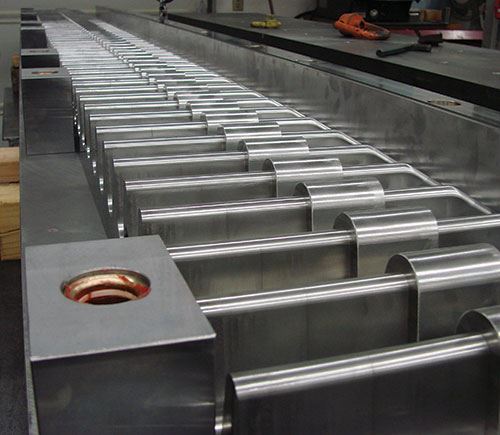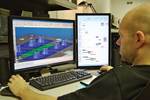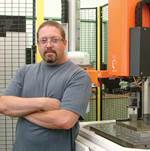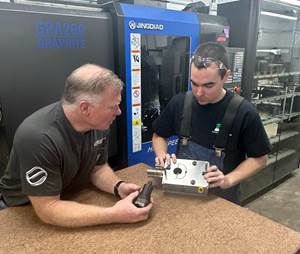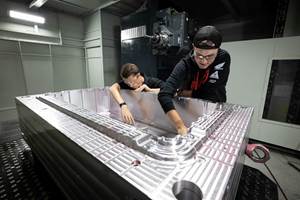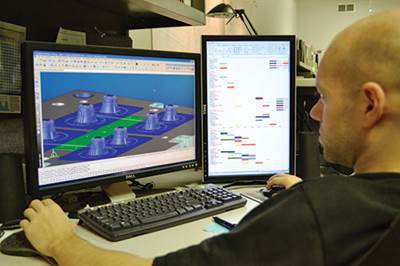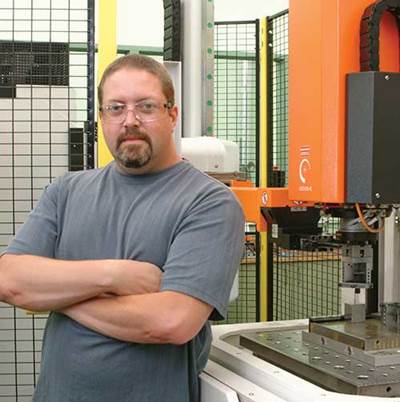Manpower, Machine Time Maximized with Highly Accurate VMC
“Using highly accurate machines allows more efficient utilization of manpower and machine time—saving time and money for the customer and making BPM more profitable.”
Buss Precision Mold Inc. (BPM; Clackamas, OR) may be small in number with 10 employees, but possesses the technology—namely a DMC 105V Linear VMC from DMG/Mori Seiki USA, Inc. (Hoffman Estates, IL)—of a larger shop to tackle molds up to 36” x 48”. This includes collapsible core, unscrewing, overmolding tools and complex action designs needing extremely high accuracy across the entire machining envelope. It was for these reasons the company sought a machine with a larger work envelope without sacrificing accuracy.
According to BPM President Jonathan Buss, tolerances and finishes on the company’s molds are tailored to the specific project, but most work is held to +/-.0002 tolerance on multi-cavity components, cavity, cores and parting lines. Thus, BPM needed a larger capacity machine that would provide the tolerances required as well as allow through- spindle coolant for drilling operations—for drilling deep holes such as are required for ejector pins, cap screws, waterlines and other mold components through thick plates and also allows spindle orientation for tapping routines. Plus, if the machine had through-spindle coolant capabilities, BPM would not have to change machines to drill different holes.
Thus, when BPM began a search at IMTS for a high-speed milling machine with a larger size capacity, through-spindle coolant capabilities were a requirement. “I gathered information from prospective builders, reviewed their offerings and then picked several to see in person at IMTS,” Buss recalls. “We had high-speed-machining centers, but we could not drill or tap holes on them. We wanted a machine with the additional solution of ‘through-spindle coolant and tapping’ on a 18K spindle.”
Conquering Challenges
Buss decided upon the 105V for its larger machining envelope (due to the portal or bridge construction), linear drives, glass scales and through spindle coolant capability with an 18K-RPM spindle for drilling—as well as milling—on the same machine. “Most high-speed milling machines do not offer through-spindle coolant for drilling ejector pin holes, or thread milling so they must be moved to another machine for that process,” he notes. “We can eliminate a step in the manufacturing process for pre-hard steel molds.” Buss adds the machine work envelope access is superior to most vertical machines of any configuration, allowing unrestricted access to two sides of the machine table.
DMG/Mori Seiki USA Executive VP Randy Harland points out that this machine does “extremely well” in mold shops for the reasons Buss outlines above. “The construction of the machine, its rigid bridge-type design, and the control technology give the 105V a unique advantage in milling of mold cores and cavities,” he says.
The machine also yielded improved surface finish. “The linear motors produced a noticeable surface finish advantage of the ball screw machines,” Buss elaborates. “We have run the same exact program, cutting tools, steel material and machining parameter on the ball screw machines, and the results are very impressive. The improved surface finish requires less polishing when specifications such as texturing or mirror finishes are required.”
Furthermore, the DMG linear drives are extremely accurate, without any axis reversal errors, Buss continues. “In recent ball bar runs, the technician thought his testing unit was malfunctioning as he had never seen a machine test so accurately on a round test pattern,” he explains. “He had to make the program out of round to confirm it was actually following the prescribed path, and once he saw the change in test data, reverted back to the original program—confirming his initial testing. He stated numerous times he had never seen a machine so accurate.”
Expanded Work, Uninterrupted
Buss is satisfied with the way the 105V has allowed BPM to take on the building of larger molds, or allow multiple workpieces to be setup and run without interruption. “One of our first jobs that utilized the extra machine travel and accuracy on the DMG was a 12-foot long mold for molding continuous conveyor belt sidewalls,” Buss recalls. “It was made up of four 3-foot sections. We would not have previously taken on a project of this size without the added travel of the machine.”
Additionally, Buss points out that these machines have allowed his moldmakers to concentrate on getting their jobs done, “instead of chasing around machining tolerance or thermal growth errors.” And, the company has reduced leadtimes significantly over when it was using conventional machinery. Buss says it is hard to measure the leadtime reduction definitively as workpieces vary. However, he says in some cases the company has spent less time polishing completed molding surfaces—at times up to 50 percent.
Keith Foster, Account Manager at DMG/Mori Seiki dealer Ellison Technologies (Indianapolis, IN), adds, “Our DMG/Mori Seiki customers that utilize DMG High Speed Linear Technology have seen great improvements in mold contouring accuracy and surface finish quality—all with a reduced cycle time. Another benefit often overlooked is that they get longer cutting tool life, which helps reduce cutting tool costs for their jobs.”
“Using high accuracy milling tools—like OSG cutters and Haimer or Lyndex/Nikken toolholders on the DMG—allows us to take advantage of the accuracies and speed of the machine for a complete process,” Buss concludes. “Using highly accurate machines allows more efficient utilization of manpower and machine time—saving time and money for the customer and making BPM more profitable.”
Related Content
Five-Axis Graphite Mill With Automation Debottlenecks Electrode Machining
Five-axis electrode cutting enabled Preferred Tool to EDM complex internal screw geometry on an insert that otherwise would have had to be outsourced.
Read MoreHow to Analyze and Optimize Cutting Conditions to Reduce Cycle Time
Plastic injection mold design and manufacturing company puts NC program optimization software module to the test. The results were surprising.
Read MoreHybrid Milling/Drilling Machine Reduces Total Mold Machining Time
MSI Mold Builders now squares, plus drills and taps eye-bolt holes on 50% of its tools in a single setup using a five-axis milling/drilling center with a universal spindle.
Read MoreThree Good Reasons to Switch from Three- to Five-Axis Machining in Moldmaking
Five-axis machining technology is a great tool in the moldmaker toolbox.
Read MoreRead Next
Getting to the “Core” of Buss Precision Mold’s Success
“We will continue to exhibit small company nimbleness to quickly adapt to our customers’ needs, while having the technology and capacity of a larger shop.”
Read MoreMoldmaker/Molder “Doubles Down” with Technology Investment
“At a time when many others are exiting the domestic tool making business because of its low margins and ever growing requirements for capital investments, we see it as a critical component to the ultimate success of our customers’ end product in the market.”
Read MoreReasons to Use Fiber Lasers for Mold Cleaning
Fiber lasers offer a simplicity, speed, control and portability, minimizing mold cleaning risks.
Read More
